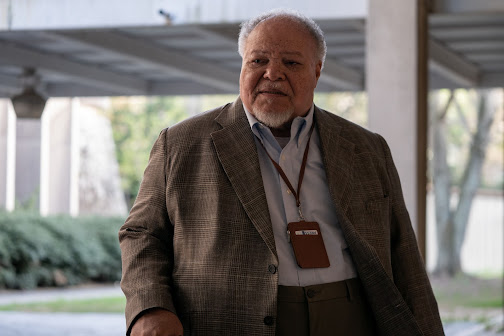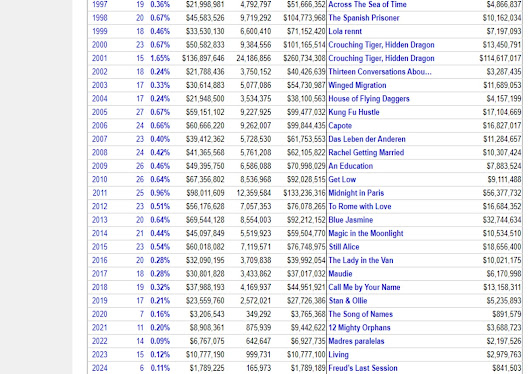"Everything in the world is about sex, except sex. Sex is about power." So said Oscar Wilde in a statement Challengers takes to heart. This motion picture about a tormented love triangle between a trio of tennis players see's sex seeping into the corner of every frame. Patrick Zweig (Josh O'Connor) and Art Donaldson (Mike Faist) cannot eat churros together or unwrap racquets on the court without evoking phallic undercurrents. Meanwhile, every move of Tashi Duncan (Zendaya) oozes confidence and planning. She knows these two men are obsessed with her. How can she use that to her advantage? The prospect of sex and the attraction between sweating human bodies is palpable throughout Challengers. No wonder it's so much darn fun to watch.
Director Luca Guadagnino and screenwriter Jason Kuritzkes take a non-linear approach to chronicling the relationship between Duncan, Donaldson, and Zweig. After we start this story in 2019, we immediately flash back to 2006 when Donaldson and Zweig were still long-time buddies. They love tennis almost as much as they care for each other. Then they get a chance to meet with Tashi Duncan, a tennis superstar. They're both immediately smitten. After the three share a magical night together, their lives are forever intertwined. Their individual dynamics especially get put into a tailspin when a severe knee injury puts Duncan's career on ice. Her time on the court may be finished...but her time on the court isn't through. She eventually moves on to coaching Donaldson while warding off the lingering advances of cash-strapped Zweig.
Challengers is so damn extra. Guadagnino already demonstrated his love for maximalist cinema with the gloriously unhinged mayhem of Suspiria and the juxtaposition of intimate romance with grisly cannibalism in Bones and All. Challengers is more grounded in terms of its plotline, but it's also a flowery production in execution. After an opening sequence intentionally framing a tennis match with aloof camerawork reminiscent of how these games are shown on TV, Guadagnino and cinematographer Sayombhu Mukdeeprom quickly throw themselves into the lively camerawork that populates the rest of the movie. Challengers finds so many unique angles to frame these physically exhausting duels through while also incorporating great touches (like beams of sweat dripping onto the camera) that make the proceedings extra immersive. The camera doesn't have to be moving for viewers to feel like they're on the court!
We live in an age of movies and TV shows informing all their blocking around looking good in TikTok's or Facebook Reel videos. The precise wider shots and vivid camerawork of Challengers is a welcome reprieve from those stifling norms. Even a conceptually simple scene like Duncan and Zweig's tense bedroom conversation is framed through memorable camerawork. Here, we see these two exchange brutal words in an extended single take and a camera bouncing back and forth between these participants (almost like it's a tennis match!). Even the non-linear storytelling helps inform some wonderful imagery. Cutting between Zweig and Donaldson practically naked in a sauna and a flashback to an encounter between fully-clothed Zweig and Duncan in a hotel lobby...ingenious. The juxtaposition between these environments (one all "proper" and sleek, the other full of exposed muscles and wooden walls) alone is striking to the eye. The ambiguity over which of these scenes most"exposes" these tennis players makes for a tantalizing thematic bedrock to this stretch of the story. Challengers is a delight for the eyeballs even beyond the endlessly attractive souls inhabiting the screen.
Something else that's welcome about this movie? Despite all the maximalist touches, it feels like it inhabits the real world more than many modern mainstream American movies. People are horny all the time and opt to take cigarette breaks. Throwaway characters (like a rambunctious older couple encountering Zweig at a motel lobby) have vivid interior lives. The proceedings all take place in "largely" normal American confines, like an Applebee's parking lot, hotel rooms, or a college cafeteria. Even the big tennis match that serves as framing device for Challengers doesn't take place at Wimbeldon. It's set at a country club with a limited number of attendees. Challengers occupies something that's consciously reality in its backdrops while its characters navigate messy sensual emotions. Plus, much like in his underrated classic Bones and All, Guadagnino demonstrates a great eye for framing these everyday domiciles. These elements of the director's latest movie are not superb just because of external trends in American cinema. However, recent shifts in this country's cinema do make it extra exciting to see Challengers commit to on-screen depictions of boners and working-class environments.
Understandably, most folks showing up to Challengers aren't here for the Mukdeeprom cinematography or to engage in discussions of phallic undertones in the on-screen imagery. They're here for Zendaya in her biggest movie role to date. Needless to say, she's an absolute force on the screen. Her depiction of Toshi Duncan is absolutely alive with endlessly planning and calculating. It's not even like she's playing chess while the two male leads are playing checkers. Zendaya depicts this former tennis superstar as playing some game we can't even comprehend while the other characters struggle to make sense of Tic-Tac-Toe. Just a big scene where Zendaya captures Duncan berating Zweig for all the failures in his life (which has big "I'm your mother" Hereditary monologue energy) alone cements her Challengers performance as something for the ages. Impressively, Faist and O'Connor don't get swallowed up by the film's lead lady and still leave a mark in their respective performances. I especially liked how O'Connor's turn as Zweig seems to have been defined by picturing what would happen if Dennis from It's Always Sunny in Philadelphia became a bulked-up tennis star.
Just as memorable as the three stars in Challengers is a rollicking score from Trent Reznor and Atticus Ross. It's been a little over a decade since this duo began regularly creating film scores with The Social Network. They've been largely crushing it with their unforgettable works since then. Even with that track record, though, they still astonish with their propulsive electronic compositions for Challengers. One's seat practically vibrates with all the energy their tracks create. The passionate internal lives of these tennis veterans are perfectly rendered in a sonic form through tracks that exude so much verve. Sexual dynamics and yearning inevitably permeate Reznor and Ross's works because, after all, "everything in the world is about sex, except sex. Sex is about power." Needless to say, Challengers has quite a lot of artistic power at its disposal.











